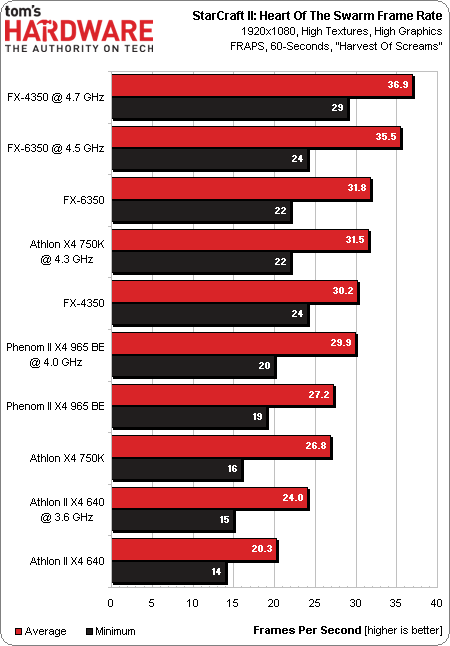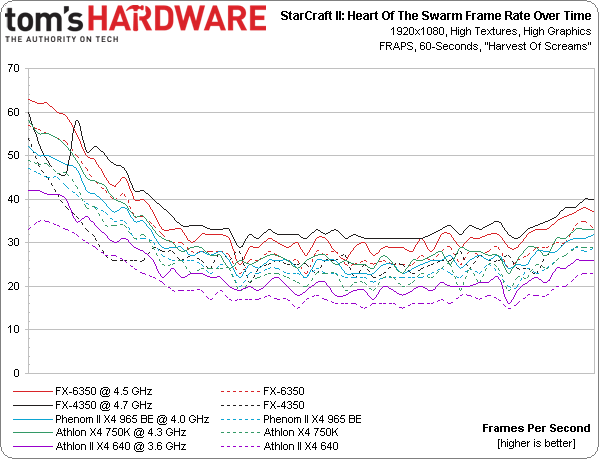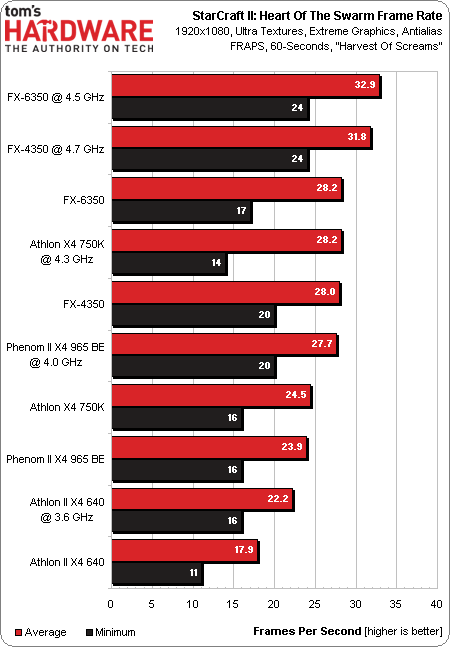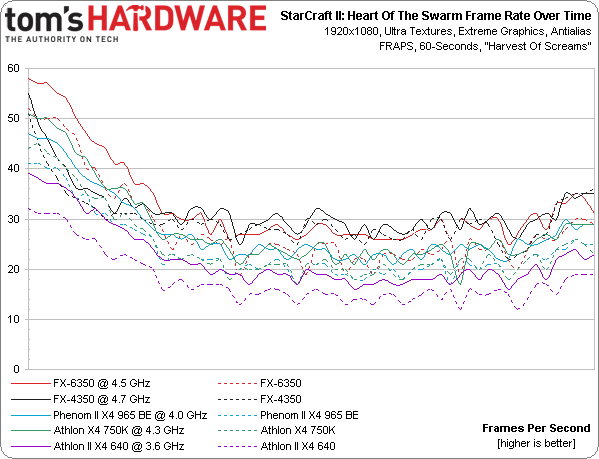AMD's Piledriver And K10 CPU Architectures Face Off
Vishera, Deneb, Trinity, and Propus are code names for some of AMD's most value-oriented processor configurations from the past couple of generations. We get our hands on several models to compare in productivity, content creation, and gaming workloads.
Results: StarCraft II: Heart Of The Swarm
While the lasting appeal of Blizzard’s popular StarCraft franchise is no doubt found within the multiplayer experience, the single-player campaigns are also a lot of fun, making them a worthy starting point for testing. Rather than using our existing Wings of Liberty map, I found that the “Harvest of Screams” mission from the Heart of the Swarm expansion really taxed my Core i5-based gaming rig. Our 60-second benchmark takes place as Kerrigan leads approximately 150 Zerg units in to destroy the mission’s final Protoss base.
I purposely delayed my attack a couple of minutes to build up more Zergling than the mission required. Plus, I kept the game camera zoomed out and centered over the action. As a result, frame rates drop substantially as more units come into view and join the battle. This may be more brutal than your own play style. After all, a Core 2 Duo E6600 is Blizzard's recommended processor. But without question, too little compute power will force you to rethink your strategy, zoom the camera in to involve fewer units, or avoid large-scale maps altogether.
StarCraft II is CPU-intensive, but unfortunately isn’t optimized for quad-core processors. Operating at the lowest clock frequencies, AMD's Athlon II X4 640 struggles the most. Its frame rates are pinned in the mid-teens once all of the units join the battle. A lack of L3 cache must be hurting it as well. Despite a 200 MHz overclocked advantage over the stock Phenom II, it still trails by about 12%.
Cranking up graphics and texture quality for this second set of numbers gets us closer to how we'd play the game with a fast GPU under the hood. Even so, our results remain CPU-limited. Overclocking is pretty much imperative with the Athlon II, since its stock-frequency frame rates hovered between 12 and 16 throughout the battle. Even then, it's barely adequate at 3.6 GHz, stuck below 20 FPS during intense action.
The Athlon X4 750K is a nice step up, competing with the Phenom II and matching AMD's FX processors once it gets overclocked. For some reason, the FX-4350 suffers a strange performance drop as the fog of war lifts. This didn't seem to be a result of textures loading, and it was repeatable on subsequent runs. More important is that, during intense action, the FX-4350 tops our chart with the highest frame rates.
Get Tom's Hardware's best news and in-depth reviews, straight to your inbox.
Current page: Results: StarCraft II: Heart Of The Swarm
Prev Page Results: Hitman: Absolution Next Page Results: The Elder Scrolls V: Skyrim-
KelvinTy So much BS, the old Phenom II X4 and X6 BE are still really competitive after all these years. Yet, if they bother to update the instruction set, and just shrink the thing, then change it to AM3+ socket, that would be great...Reply
K10 has so much more potential... -
Personally, I was surprised to see the FX-4350 do so well. The bump up, compared to the FX-4300, has really done it some good.Reply
-
MU_Engineer Kelvin, the tests showed that the Piledriver FXes are not that far off the Phenom IIs clock for clock and core for core. The Phenom II X4 965BE at 4.0 GHz was generally about as fast as the stock FX-4350 running 200-400 MHz faster so you figure about a 5% per-clock, per-core advantage for the Phenom II. However, each Piledriver core is quite a bit smaller than a K10 core and they also have a longer pipeline so they can clock quite a bit faster (K10 was pretty well tapped out.) So you get more cores and more clocks out of Piledriver with essentially the same performance per core and per clock. I'd say that the modular architecture used in the FXes finally got the vindication it deserved with this test. Way to go Tom's.Reply -
Onus As I was going through this, at first I was worried about the absence of comparison to Intel, but was relieved to see it at the end. Especially if I don't want to push my 970BE really hard (I'd rather play on my PC than with it), the FX-63x0 looks like a viable upgrade.Reply -
cmartin011 I want some juice GPU news. I am aware they are not going anywhere fast with CPUs. My wallet will be open for 8 core in 2 years when performance Increases 20%Reply -
magnesiumk Thank you so much for writing this article. Thank you also for including the Phenom II 965 processor to this test. I use it, and it is somewhat dated, and hard to find compared to newer cores. However it still kicks a lot of butt in gaming. I bought my Phenom II 955BE C3 last year with overclocking in mindReply
I always wanted to see how it would compare to newer models, and even intel counterparts. Thank you for this. I loved reading the article. Keep comparisons like this coming. -
magnesiumk I also wanted to add, thank you for listing the 965BE with overclock at 4Ghz. It's easy to clock this processor up to those speeds. That's about what I run at, and it also runs much greater than stock speeds. This is important in future comparison tests. Thanks again.Reply -
envy14tpe Wanted to see i3 and i5 CPUs on the charts. Not just in the "Wrapping things up" section. Also, why not compare to a i5-3470? It's locked, cheaper, and still fast.Reply -
crisan_tiberiu if the 6350 is so close to the 3570k the 8350 eats it alive..and everybody recommends the i5 ^-. AMD has still good valueReply



